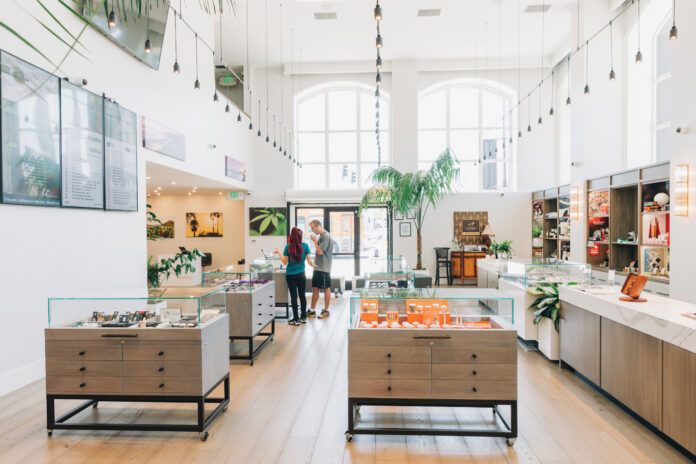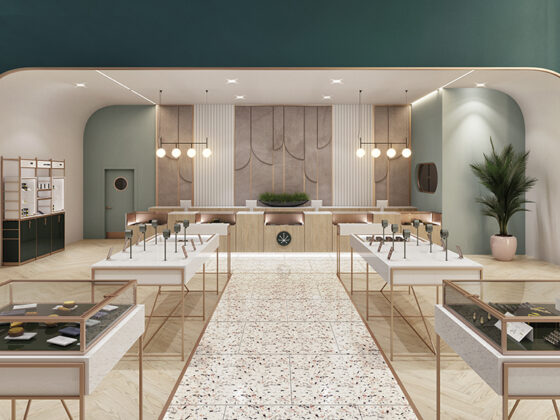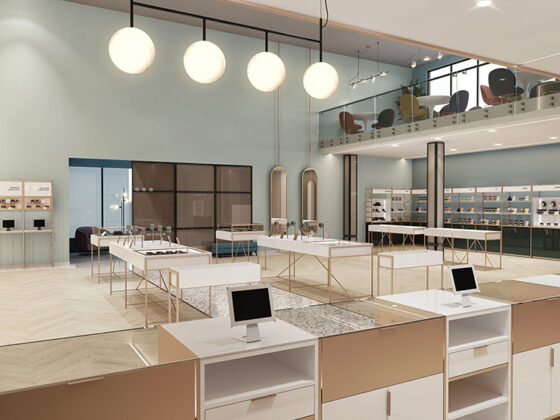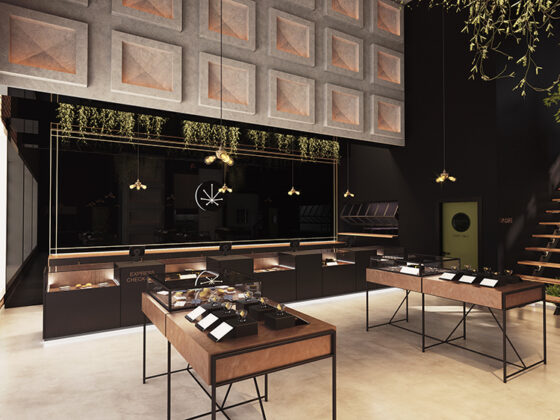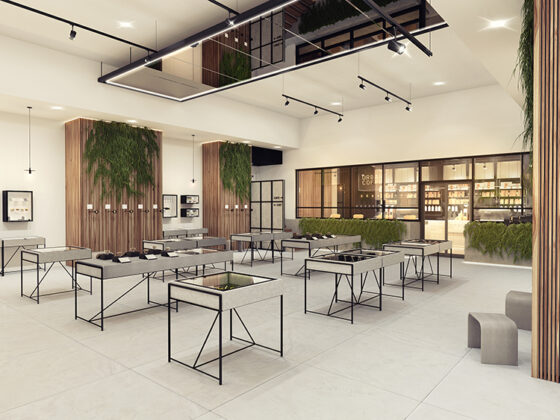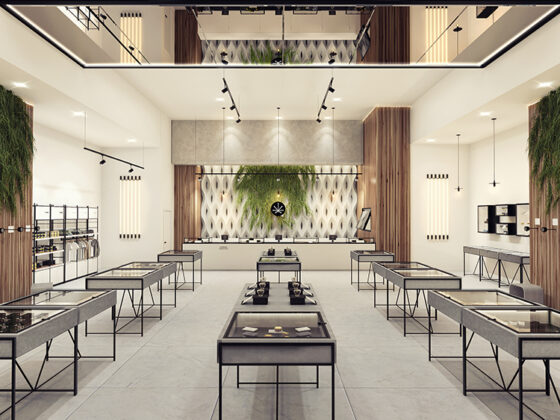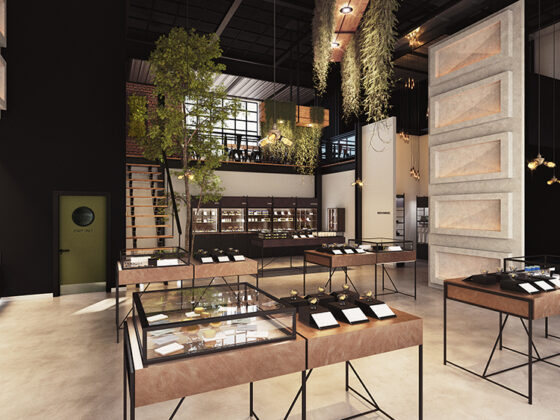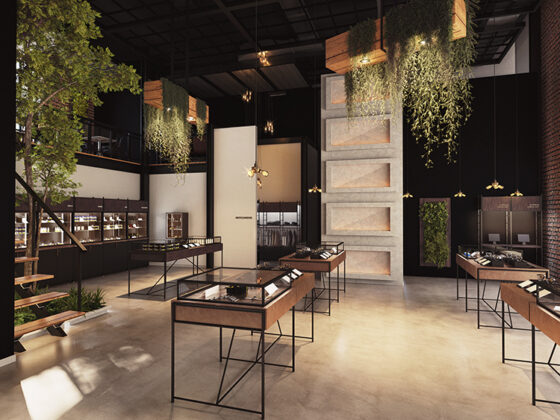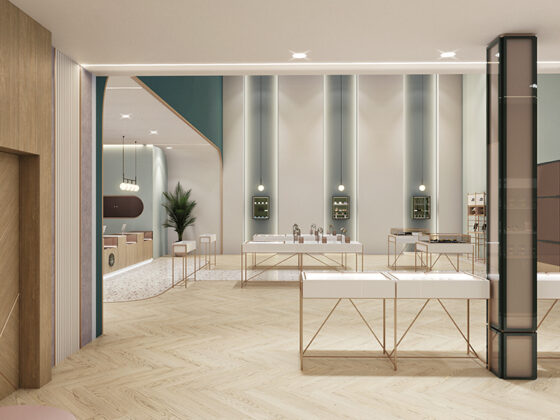My first dispensary design assignment for mg Magazine in early 2019 took me into the affluent Los Angeles neighborhood of Woodland Hills to profile a shop called Atrium. The opulent salon-meets-jewelry shop’s floor glistened in a flood of natural light. The attentive, diverse staff thrummed around the open floor with iPads, offering recommendations and patiently explaining each product. Design-forward brands like dosist and Canndescent had claimed their own sections of the store, meticulously presenting their products in an environment that finally felt appropriate.
During the hour or so I spent taking in the details, I watched as new consumers timidly handed over their IDs at the door before the tension fell from their shoulders and they stepped into the impeccably designed, open space. This was not a drug deal.
Design is the unsung hero of cannabis’s path toward normalization. Since states started legalizing adult use, branding, packaging, and stores’ interior design have been systematically dismantling the outdated stereotypes rolled up with the plant since the late 1960s.
“It’s the Trojan horse of this industry,” said cannabis retail pioneer Megan Stone, whose High Road Design Studio was the first to bring elevated retail architecture to dispensaries beginning a couple of cannabis eras ago in 2013.
Beset with a particularly complex web of regulatory oversight and ongoing scrutiny from local politicians and their conservative constituents, dispensaries in affluent areas, particularly, have used architecture and interior design as part of their bid to snare coveted licenses. mg profiles design-forward shops every month because they are, as Stone rightly observed, safe access points for the new consumers who are key to the industry delivering on its financial projections and societal potential.
As traditional brick-and-mortar shops endured a grueling 2020, dispensaries flourished. Deemed essential businesses at the beginning of the pandemic, the stores met the surge in demand for products by pivoting to pick-up and delivery, bolstering online ordering capabilities and in turn shoring up resilience throughout the industry supply chain.
And that makes the timing of this showcase all the more relevant: Which COVID-19-induced changes will become permanent? Which pre-pandemic trends will remain relevant? More broadly, how can stores remain both flexible in the face of ongoing regulatory and consumer-preference evolution while maintaining enough consistency to become familiar brands with true longevity?
Open Plans and Modularity
The first significant design leap for dispensaries was removing the walk-up counter in favor of open floor plans with glass cabinets and shelving units to display products. The first generation of dispensaries called to mind bygone confectionary stores, requiring customers to stand at a counter and direct a budtender to remove products from jars. For less experienced users, this was challenging: Conscious of the line forming behind them, unable to get a good look at the merchandise, and afraid to ask “stupid questions,” they often suffered through an experience that might charitably be called intimidating. The counter created an uninviting environment, especially for those new to dispensary shopping.
Embracing open plans and a customer-guided design helped stores build trust with consumers across a variety of experience levels. “Open floorplans allow customers to explore and shop dispensaries more independently, which many people prefer,” explained Stone, who utilized open plans in many of the sixty-two dispensaries she designed in seventeen states. “It also creates a more approachable retail experience that feels less intimidating.”
Browsing increases the likelihood of additional purchases and can help dispensaries maximize revenue per square foot. To do that effectively and engagingly, modular storage cabinets showcasing buds and housing point-of-sale stations recently have become fixtures in upmarket shops.
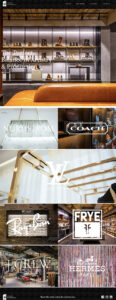
Toronto fabrication and interior design studio SevenPoint Interiors democratizes luxury dispensary design with turnkey cabinet and shelving units aimed at helping smaller and less capitalized operators. The Module System is a catalog of elegant, cannabis-specific merchandising units that allow stores flexibility in displaying a wide array of products.
“We’ve learned over the years that not everyone has the budget or the time to do a custom design,” said Danielle Marzarella, vice president of global business development for Visual Elements, SevenPoint’s parent company, which counts Nordstrom, Coach, and Louis Vuitton among its clients. “We invite potential clients to share their budget and timeline with us, and we’ll work through a catalog of options with them. Or they can share their floorplans with us, and we can create a design using these turnkey solutions and pick some finishes to match their brand.
“We’re very proud of the flexibility of our modules,” she continued, highlighting the number of finishes and materials the company offers to match clients’ brand aesthetic. “It can really help when it comes to speed-to-market.”
Experienced cannabis retail designers almost universally cite flexibility as a virtue, and modular display units enable the trait in a way fixed counters don’t. “A lot of places do events at night, and [movable display cases allow staff to] unlock and roll them away as they please,” said Gi Paoletti, the architect behind Stiiizy’s notable retail projects in Los Angeles and her native San Francisco. “I’m starting to build that kind of flexibility into the dispensaries I work on.”
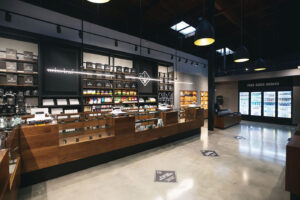
Modularity also can be effective in dispensary design at the point of transition from medical to recreational, or if operators intend to open multiple locations under the same brand. Urbn Leaf’s first dispensary in San Diego opened in 2017, built-in preparation for the adult-use market and the expected deluge of an entirely new market segment. Today, the company operates seven stores throughout California, all of them adapted for non-traditional spaces governed by different municipalities while never losing the essence of the brand’s identity.
“We really tried to develop a common language that can be adapted to different contexts,” said Barbara Leon, co-founder of Heleo, the architecture firm behind Urbn Leaf. “With Urbn Leaf, for example, wherever there are [point-of-sale] systems we house them in walnut millwork with glass cases between them. While the specific dimensions will change to match the layout or floor plans, this feature is present in every store.”
Modularity not only helps achieve consistency but also can support novelties and temporary activations. Paoletti provided Stiiizy many opportunities to keep the dispensary design fresh for the 1,500 to 2,000 Gen Z and Millennial consumers who visited the L.A. location daily prior to the pandemic. For instance, a pair of Instagram-worthy booths have removable panels that allow management to change the interior as frequently as they like.
Integrating brands and merchandising
The rise of high-end design on the brand identity and packaging sides of things unquestionably has influenced store design.
“Packaging has become amazing in the cannabis industry, especially in California,” said Stone, who worked part-time as a budtender in an Orange County, California, dispensary while attending design school. “When I first started designing dispensaries, planning the product displays was really difficult. Aside from presenting flower in deli cabinets, there was nothing we could elevate and put up on display. It was pop-tops and no-brands.”
Today brand merchandising is growing in visual dominance as dispensaries seek new revenue opportunities by offering wall wraps and shelf-space buyouts. To seize this opportunity, Stone recommends “incorporating dedicated places or good signage and graphics to be replaced, added, and refreshed over time.”
Urbn Leaf developed its immaculate organic-industrial aesthetic just before merchandising became the norm. Rather than adapt the chain’s minimalist black-and-walnut palette, which gives the house brand visual dominance in stores, the company created a pop-up area for brand partners to build out presentations for a month at a time.
“Urbn Leaf’s owners didn’t want to disrupt their branding, so they requested we integrate a shop-within-a-shop format and give the brands an entire corner of the store,” Leon, the architect, explained. “We developed these customizable free-floating islands that hover between the browsing experience and the budtender experience.”
While this form of merchandising is widely deployed in competitive, multi-brand retail environments like grocery and department stores, Paoletti believes there is a point of excess. “The owners of the stores have to be careful because if you’re monetizing every surface it starts to hurt the customer experience,” she said, adding it has become part of her job to talk dispensary owners away from spoiling their design with an aggressive merchandising strategy.
While cannabis presentation has advanced considerably during the past few years, integrating brands into a cohesive design still presents challenges. Often, an aesthetic tension exists between headier brands that remain loyal to the old-guard culture and the cosmetics-inspired feminine brands that have emerged more recently. Any dispensary with high design priorities must confront the conundrum of giving customers the best range of product options without the store looking like a smoke-shop trade show hosted at a health spa.
Education-driven dispensary design
Stores trying to entice new customers must consider education and how design may support the effort. Typically, designers subscribe to one of two schools of thought depending on the clientele and how they use cannabis: dedicated consultation areas or customer-guided exploration.
For Synchronicity Holistic in Carmel-by-the-Sea, California, Stone’s High Road studio carved out a beautiful, semi-private consultation area where the dispensary’s customers meet with the in-house pharmacist. Synchronicity owner Valentia Valentine—a 66-year-old entrepreneur who has lived with multiple sclerosis for more than thirty years—worked with Stone to gear the environment to affluent women older than 50 who embrace cannabis primarily as an alternative to pharmaceuticals.
For stores with extra space and a medical-heavy clientele, creating a consultation area that allows customers to begin their exploration guided by a sales associate can anchor the experience in a familiar patient-pharmacist relationship.
But when it comes to a recreational consumer base, Paoletti observed some new customers feel embarrassed about being taken aside for a cannabis 101 lesson in front of other customers. “A lot of people don’t want to be sitting in a lounge chair with a budtender teaching them all about cannabis,” she said. “It’s more comfortable to do it on the fly, discreetly, while standing. If they feel too embarrassed or too intimidated, they are just going to walk out. You not only lose that sale but also the potential for a repeat.
“Once you make these people comfortable, they will come back to your store at least several times before they try a different store,” she added.
Stores like the Lightshade chain in Colorado have used idle space in the lobby to explain their product-grading system using colorful wall-mounted graphics. Lightshade’s in-store nomenclature—Enliven, Inspire, Calm, and Rest—abandons the confusing indica-sativa-hybrid and strain name verbiage in favor of helping consumers find the effects they seek without too much budtender handholding. The approach helps some skittish consumers feel more comfortable.
Nervous new consumers enter dispensaries every day, particularly in emerging markets. Education is immensely important for them, so consider how much customers want or need and where they feel most comfortable receiving information. Retailers that see a huge upside in chasing new cannabis consumers should take this seriously when considering their store build-out, because ensuring new customers feel comfortable can make the difference between creating a customer for today or for life.
Social media placemaking
When Stiiizy selected Paoletti to design the company’s stores, the creative brief insisted the spaces be “Instagram-able.” As one of the most high-profile cannabis brands on Instagram, boasting more than 450,000 followers in March, Stiiizy considers its properties to be potent backdrops and essential for dominating the platform.
“When you think about making an entire space Instagram-able, you’ve got to consider what’s going to inspire someone to want to take a picture and share it with their friends,” Paoletti said. “What’s going to create that ‘wow’ factor?”
The brand’s cavernous retail warehouse in downtown Los Angeles is outfitted with photo walls, LED-lit tapered tunnels, and art from iconic local street artists like Renta. “I had the room to make the whole space Instagram-able but keep consumer flow going so Stiiizy could get their 1,500 people per day through the space,” she said. Despite the importance of making the space hype-worthy, Paoletti said the store’s priority firmly lay in generating dollars, not likes, and that led them to put the Instagram stations away from the shop’s traffic flow. “That was the compromise: If you want to do the Instagram thing, you can go to the corner away from the line of traffic,” she said.
Urbn Leaf also consciously creates backdrops for social media, though in a subtler way. Leon and Heleo co-founder Carlos Hernandez installed a living wall emblazoned with the store’s slogan, “Feel Good Drugs,” in cursive neon tubing, which is a placemaking trend that has infiltrated every hip bar, restaurant, and coffee shop in the country.
Perhaps there’s something more in the strategy. As any dispensary social media manager surely will know, the threat Instagram will suspend an account for posting cannabis content is higher than ever. But given the same rules are not applied to personal accounts, actively encouraging customers to broadcast the store to their followers can help businesses reach relevant people with less anxiety.
Paoletti, always the voice of caution, was quick to discourage dispensary owners from getting carried away with the Instagram-able idea, given the fickle gales of social media and the conflation between buzz and revenue. “That is another area where I’m pushing back, because they’re thinking, ‘This is all the rage, so we have to provide it,’” she said. “I’m saying, ‘Let’s really think about this. What comes first to you?’ It’s always sales.”
Digital and omnichannel strategies
The U.S. Department of Commerce reported ecommerce sales rose 32.4 percent year-over-year in 2020, with the pandemic hastening mainstream society’s transition to a digital-forward retail environment by as much as five years. Cannabis commerce was no different. Dispensaries were pushed to develop an “omnichannel” approach in which more and more consumers ordered online and picked up at a store.
While many retailers scrambled to adapt to the new reality, Florida-based multistate operator Jushi Holdings Inc. saw the development as inevitable. Immediately after becoming chief creative officer in February 2020, Silicon Valley ecommerce veteran Andreas Neumann rebuilt the website for the company’s Beyond / Hello dispensary chain to respond directly to a new reality. “All the customers wanted was to see the product and order it for pick-up,” he said. “Our job is to create the fastest path to the product, and it cannot be more than three clicks.”
Guided by a “buy-versus-build” philosophy, Neumann looked to Jane Technologies’ I Heart Jane platform to deliver a robust menu and order processing while focusing his team’s efforts on optimizing the Jushi site’s architecture around the Jane interface. “Tesla buys their parts from companies like Mercedes but powers those parts with their brain,” he said. “We buy our shopping cart from I Heart Jane, but we build our brain in-house.”
The strategy is paying off in a big way, according to Neumann. Beyond-Hello.com has a run rate of $120 million and has become what he dubbed “our biggest store.”
I Heart Jane powers online menus for more than 2,000 dispensaries nationwide. Early in the pandemic, the platform saw online ordering account for 52 percent of all dispensary transactions, up from a pre-pandemic level of 17 percent; since then, the increase has fallen to about 42 percent, which still is a respectable hike. Jane Technologies founder and Chief Executive Officer Socrates Rosenfeld believes the numbers represent a shift in consumer habits that likely won’t revert after the country emerges from forced hibernation. “As retail continues to digitize globally, the cannabis industry is a leading indicator of what’s to come: A world where consumers can shop [online] for the products they love directly from the retailers in their neighborhood,” he said.
By treating their websites as a lead generator for brick-and-mortar stores, dispensaries can gather a vast trove of actionable customer data. This highlights a key structural advantage unique to cannabis retailers: As the gatekeepers between the entire industry and the consumer, retailers own the customer relationship and can communicate with shoppers in a way brands can’t. And they can—and probably should—capitalize on their position by encouraging customers to begin their shopping experience online.
Curbside and express pick-up, though introduced to address a temporary situation, are here to stay and should be a permanent design consideration for new and existing stores. “Across the board, this has become second nature for people to expect, want, and seek out,” said Stone, who actively encourages retailers to create a specific section of the store for curbside pick-up. “We like to create good transaction space, inventory space, and counter space so a dedicated staff can do nothing but service express-order customers. We see clients doing 30 percent to 50 percent of their business out of this area of the store, so paying attention to the details can really increase sell-through and customer satisfaction and decrease wait time.”
Experiential retail
Although virtual shopping is here to stay, designers expect the pendulum to swing back toward in-person gatherings post-pandemic. They also expect the shopping experience will be influenced by the insurgent Gen Z consumer demographic and its desire for engaging, immersive “moments.”
“Gen Z is a really interesting consumer group,” said Paoletti. “If there are plants indoors, they want to really feel like they are outdoors. They want to feel the breeze and have the whole thing conjured up for them. Millennials just want to be able to order [a product] and get it. Gen Z is looking for something experiential.”
Experiential retail concepts seek to draw customers to the store for something more than products. The trend has emerged as the most credible competitive advantage brick-and-mortar retailers can deploy to slow the transition from foot traffic to web traffic.
Beyond / Hello aggressively is laying the foundation for experiential retail inspired by clothing retailer Fred Segal. The Beyond / Hello concept will hybridize dispensary, coffee shop, fashion store, and event space into what Neumann dubbed the “retail scene.” “We want to use cannabis-adjacent culture and exclusive products to bring people to the store,” he said. “That might mean pop-ups with rare brands you can’t get anywhere else, limited-edition products, music and film collaborations, art exhibitions. This is the next phase of cannabis retail.”
Paoletti’s buzzworthy work with Stiiizy and an elaborate forthcoming concept in Los Angeles indicate experiential retail is likely to flourish when large-scale gatherings become safe again. “People are coming to me because I create these unique immersive experiences while still making sure the stores can process a high volume of orders,” she said.
A chance to lead
Traditional retail endured a year that could scar the sector for a generation, particularly as malls and high streets face a difficult road to recovery and Amazon’s increasing dominance poses an existential threat to all direct-to-consumer ecommerce operations. Two thousand twenty was the breakout year for cannabis nationally, with point-of-sale and inventory-management software provider Flowhub reporting a 67-percent increase in U.S. sales. Given retailers and delivery services continue to enjoy a vice-like grip on the customer relationship, they could be the biggest winners to emerge from the pandemic.
This gives dispensaries a rare opportunity to step out of the shadow of traditional retail and become brick-and-mortar leaders. Based on the dramatic transformation of cannabis store design over the past five years, stores that prioritize design have become the norm rather than the exception.
“The stores today are incredibly sophisticated compared to where they were when we started in 2013,” Stone said. “COVID-19 has led to delivery and curbside really opening up and an industry-wide effort to make access more simple and safe. This has spurred evolution even faster than it was already going.”
Add to that the increasing stability of retailers, new means of increasing margins and generating revenue, and the imminent rise of consumption lounges, and dispensaries start to look like an exciting breeding ground for creative ideas fortified—for now, at least—by regulation that keeps consumers in their domain.
“Cannabis has really proven itself from a business perspective,” Stone said. “That has certainly helped us get better access to services and consultants like architects and engineers, fixture vendors, and lighting designers. It’s easier to do great work when you work with great people.”
Is this cannabis’s time to lead the way in retail as a whole? “The pandemic proved cannabis is an essential business, and this has opened up incredible opportunities everywhere,” Stone said. “It’s ours to lose.”







